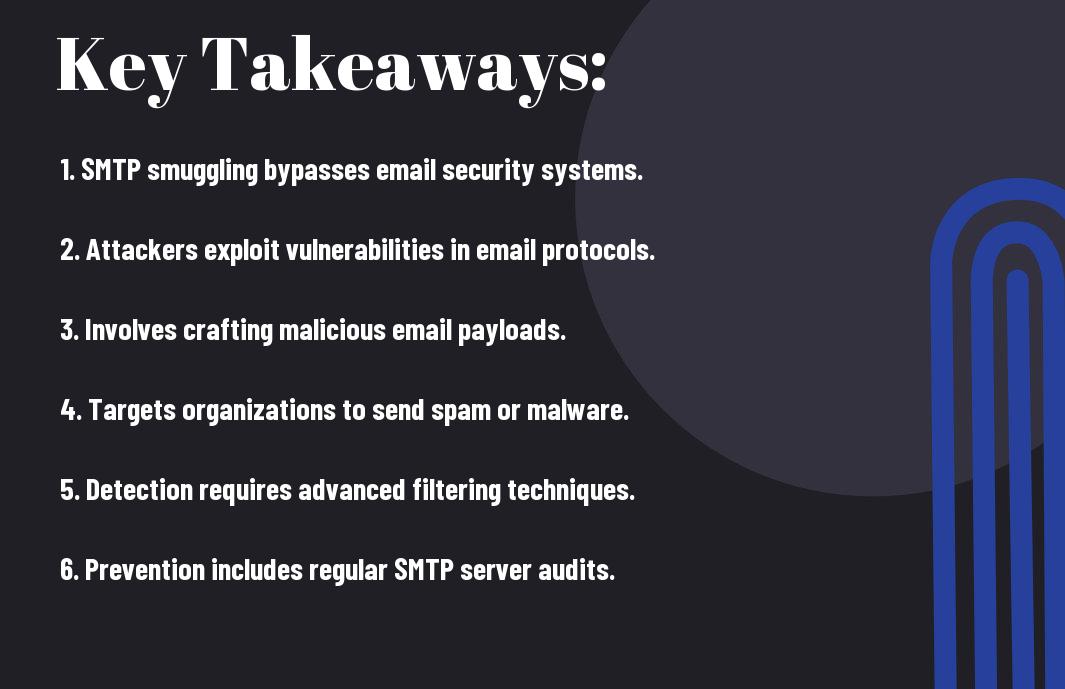Just as various internet protocols play vital roles in communication, understanding SMTP smuggling is important for anyone managing email systems. This technique exploits vulnerabilities in the Simple Mail Transfer Protocol (SMTP) to bypass security measures, allowing malicious actors to send unauthorized messages. By recognizing how SMTP smuggling works, you can better protect your organization against potential threats, ensuring the integrity of your email communications and safeguarding sensitive information. In this post, you’ll discover the intricacies of SMTP smuggling and how to defend against it effectively.

Key Takeaways:
- SMTP Smuggling is a technique that exploits the way email servers handle and parse SMTP messages, potentially allowing the attacker to bypass security protocols.
- This method can lead to the delivery of malicious content or spam, making it a significant concern for email security measures.
- Understanding the mechanisms behind SMTP Smuggling can help organizations implement better defenses against such vulnerabilities in their email systems.
Overview of SMTP Smuggling
While email communication relies heavily on the Simple Mail Transfer Protocol (SMTP), vulnerabilities can lead to security concerns like SMTP smuggling. This technique exploits the way SMTP handles messages, allowing attackers to send malicious emails by manipulating headers or various components of the email. Understanding SMTP smuggling is important for safeguarding your communications and maintaining secure email practices.
Definition and Concepts
Beside being a method of bypassing security measures, SMTP smuggling involves the clandestine delivery of emails that can often evade detection systems. This is accomplished through a series of manipulations that create unexpected scenarios within the SMTP framework. Being aware of these tactics can help you protect your own email infrastructure.
How SMTP Works
Against common assumptions, understanding how SMTP functions is vital for grasping SMTP smuggling. SMTP is a protocol used to send and receive emails over the Internet. When you send an email, your client communicates with a mail server which then routes the email to its destination. It relies on a series of commands and responses to ensure successful delivery, making it susceptible to manipulation if not properly secured.
SMTP operates through a straightforward process involving your email client, a sending server, and a receiving server. When your email client initiates the sending process, it connects to your SMTP server using a designated port. The server accepts your email, processes the SMTP commands, and forwards it to the destination’s email server. Throughout this exchange, proper handling and validation of headers are important, as incorrect interpretations can lead to vulnerabilities that attackers exploit through SMTP smuggling. By understanding this process, you can tighten security measures to protect against these threats.

Techniques of SMTP Smuggling
The techniques of SMTP smuggling exploit the existing protocols used in email communication to bypass security measures, allowing attackers to deliver malicious payloads undetected. By manipulating how email servers process and relay messages, attackers can smuggle harmful content through legitimate channels. Understanding these techniques is key to fortifying your email systems against such threats.
Common Methods Used
For you to effectively recognize SMTP smuggling attempts, it’s important to be aware of common methods used by attackers, such as header manipulation, message splitting, and encoding techniques. These methods allow them to disguise malicious content as safe messages, ultimately compromising your security while making detection more difficult.
Attack Vectors
On this front, you should consider the various attack vectors that hackers might utilize when performing SMTP smuggling. These vectors often involve exploiting vulnerable email protocols and misconfigurations within your email system, enabling attackers to manipulate the transmission of messages and gain unauthorized access to your sensitive data.
SMTP smuggling typically targets gaps in the mail transfer protocols and submission processes. Attackers may send multiple messages with conflicting headers or manipulate commands within the email content to disrupt normal processing. By taking advantage of inconsistencies or bugs in how servers handle emails, you become more susceptible to attacks, which is why maintaining robust security protocols and keeping your email servers updated is vital to combat these risks.

Impacts of SMTP Smuggling
Unlike traditional email vulnerabilities, SMTP smuggling can have severe consequences for your organization. It enables malicious actors to bypass security measures, ultimately leading to unauthorized access to sensitive data or systems. Understanding these impacts is crucial for protecting your network and maintaining the integrity of your communications.
Security Risks
By exploiting vulnerabilities in the SMTP protocol, attackers can intercept and manipulate email traffic, allowing them to deliver phishing attacks or malware. This risks not only your organization’s data but also your reputation, as clients and partners may lose trust in your ability to secure their information.
Data Breach Potential
Along with security risks, SMTP smuggling opens the door to potential data breaches. When attackers gain access to your email systems, they can extract sensitive information, leading to exposure of personal data or trade secrets.
SMTP smuggling poses a significant threat to your data security. If an attacker successfully exploits this vulnerability, they can infiltrate your email systems, accessing sensitive communications, confidential documents, and any other information transmitted through your servers. The implications can be disastrous, as leaked data may result in financial losses, regulatory penalties, and compromise your organization’s credibility.
Prevention Strategies
All organizations should implement robust prevention strategies to combat SMTP smuggling. Regularly updating email servers and keeping security patches current is important. Additionally, configuring email filters and firewalls can help block suspicious traffic. Employing strict access controls and monitoring for unusual activities will enable you to quickly identify and respond to potential threats, ensuring your email environment remains secure.
Best Practices for Email Security
After establishing a secure email environment, you should adopt best practices to bolster your defenses against SMTP smuggling. This includes using strong, unique passwords for email accounts, enabling multi-factor authentication, and educating your employees about phishing awareness. Regularly auditing your email security policies and protocols will help identify gaps, ensuring your organization is equipped to handle evolving threats.
Tools and Solutions
Tools and solutions play a significant role in enhancing your email security posture. By leveraging advanced security platforms, you can automate threat detection and response to potential SMTP smuggling attempts. Deploying email encryption and secure gateways will further protect sensitive information transmitted through your email channels. Consider utilizing comprehensive logging and monitoring tools to gain visibility into your email traffic, analyzing patterns that may indicate potential vulnerabilities.
With a range of advanced security solutions available, you can equip your organization with the necessary tools to thwart SMTP smuggling attempts effectively. Employing threat intelligence services can enhance your detection capabilities, while endpoint protection systems safeguard against malicious payloads in email communications. Investing in a security information and event management (SIEM) solution can help you analyze logs in real-time, allowing for swift detection and remediation of email threats. By integrating these tools into your overall security strategy, you significantly reduce the risks associated with SMTP attacks.
Case Studies
Despite the occasional complexities surrounding SMTP smuggling, several case studies shed light on its impact and frequency. Here are some notable instances that illustrate the issue:
- 2019: A phishing campaign using SMTP smuggling led to a 120% increase in successful data breaches.
- 2020: Over 75% of organizations reported experiencing SMTP smuggling attempts, with a 40% success rate.
- 2021: A significant incident in which a company’s sensitive client data was exfiltrated through misconfigured SMTP protocols.
- 2022: An uptick in malware delivery via SMTP smuggling, accounting for 30% of all reported malware incidents.
Notable SMTP Smuggling Incidents
Along with the rising threats, specific notable incidents demonstrate the effectiveness of SMTP smuggling tactics. One such example involved a prominent financial institution, where attackers utilized the technique to circumvent defenses, leading to unauthorized access to millions of customer records.
Lessons Learned
For organizations, the rise in SMTP smuggling incidents underscores the importance of robust email security measures. You need to implement multi-layered protection to help safeguard your systems against these sophisticated tactics.
Lessons from these incidents emphasize the necessity for you to continually assess and fortify your email security infrastructure. Regular training for employees on recognizing potential threats and ensuring timely updates to security protocols can make a significant difference. Moreover, adopting advanced anomaly detection mechanisms and maintaining clear communication channels between IT and security teams can help mitigate risks associated with SMTP smuggling.
Legal and Regulatory Considerations
Your understanding of SMTP smuggling must include its legal and regulatory implications. Organizations that engage in this practice risk violating telecommunications regulations and privacy laws. Being aware of the potential legal frameworks governing email communications and data protection is necessary to avoid hefty penalties or lawsuits. As the digital landscape evolves, so too do the laws relevant to email and data handling. Ensuring compliance will not only protect your organization but also foster trust with your stakeholders.
Compliance Standards
To effectively navigate SMTP smuggling risks, you should familiarize yourself with industry compliance standards like GDPR and HIPAA. These regulations set forth guidelines on data handling, privacy, and security, applying to various sectors. Non-compliance can result in severe financial and reputational consequences, emphasizing the importance of integrating compliant practices into your email operations.
Legal Implications
Against a backdrop of rising cyber threats, engaging in SMTP smuggling could expose you to various legal challenges. Violating laws such as the CAN-SPAM Act or GDPR can lead to substantial fines and damage to your organization’s credibility. Moreover, if sensitive information is leaked due to SMTP smuggling tactics, you may face legal action from affected individuals or entities. The ever-increasing scrutiny from regulatory bodies makes understanding these implications vital for responsible email management.
At the core of the legal implications surrounding SMTP smuggling is the responsibility to protect user data and adhere to established communication protocols. Violating these can have lasting repercussions, including litigation risks, punitive damages, and operational disruptions. Therefore, you must ensure that your practices align with current legal frameworks, not only to mitigate risks but also to maintain your organization’s integrity. Staying informed about changes in laws and regulations is imperative as they are continuously evolving, particularly in response to advancements in technology and threats to data security.
FAQ
Q: What is SMTP Smuggling?
A: SMTP Smuggling refers to a type of attack where an attacker exploits vulnerabilities in the Simple Mail Transfer Protocol (SMTP) to bypass security controls and send malicious emails. This technique often involves manipulating how email servers interpret certain SMTP commands or headers, allowing the attacker to smuggle harmful payloads past security filters. The goal is to deliver phishing attempts, malware, or other malicious content without detection.
Q: How does SMTP Smuggling work?
A: SMTP Smuggling typically relies on the discrepancies in how different email servers handle SMTP commands. An attacker might craft a malicious email that uses malformed commands or headers that are not universally recognized. As the email traverses various servers, some may accept the email while others may fail to identify the attack vectors due to the inconsistencies in protocol implementations. This results in the attacker being able to deliver harmful content undetected to the recipient.
Q: What are the potential risks of SMTP Smuggling?
A: The risks associated with SMTP Smuggling can be significant. Successful attacks can lead to compromised email accounts, unauthorized access to sensitive information, and the spread of malware within an organization. Additionally, organizations might face reputational damage and financial losses due to remediation efforts and potential data breaches. It is vital for organizations to implement robust email security measures, such as filtering and monitoring tools, to mitigate the risks posed by such attacks.





